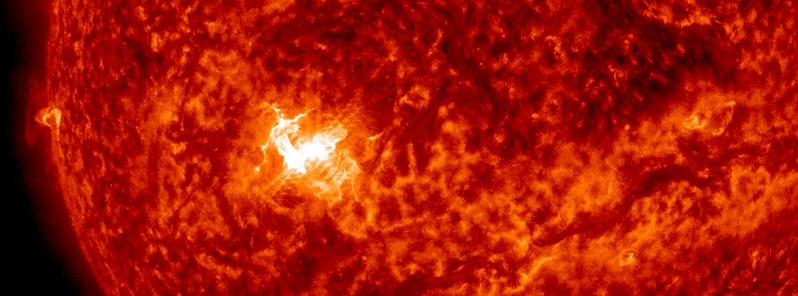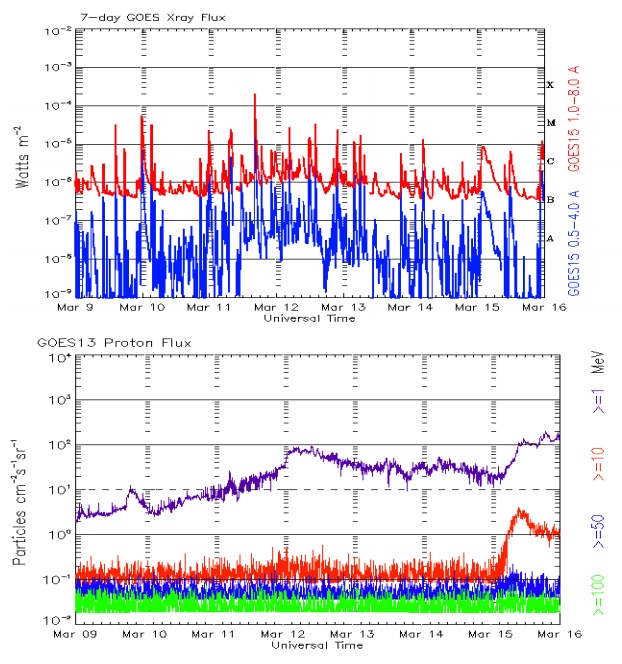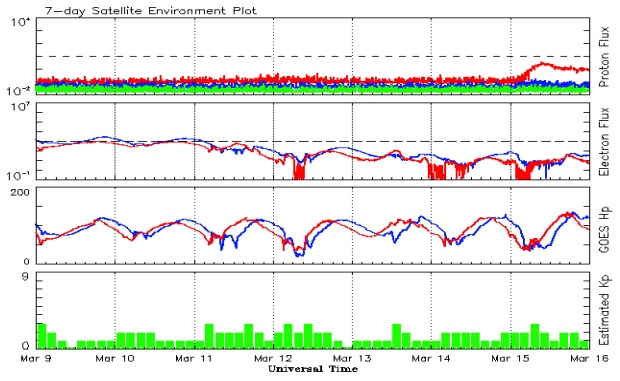Space weather highlights for March 5 – 15, 2015

Region 2297 rotated onto the SE limb on March 5, 2015 and by March 15 it managed to produce a total of 99 C-flares, 24 M-flares and 1 X-flare. From March 8 to 12, it was the only numbered sunspot region on the solar disk and from the end of March 5 to March 16, with just a few exceptions, it was the solo event producer.
A long duration M9 flare which erupted from Region 2297 on March 7 had a 260 sfu Tenflare associated, as well as a Type II (estimated velocity 704 km/s) and Type IV radio emissions, and a partial-halo Coronal Mass Ejection (CME) with an approximate plane-of-sky speed of 1 225 km/s.
By March 9, this region produced 4 M-class solar flares, but due to its location close to the east limb, no CMEs were expected to be geoeffective.
Solar activity reached high levels from March 9 to 12 as region 2297 produced several greater than M5 flares including X2/2b flare at 16:22 UTC on March 11 with an associated 160 sfu Tenflare, Type II (estimated velocity 1 461 km/s) and IV radio emissions, and a non-Earth directed CME.
Also, a 22 degree long filament erupted on March 11; it was centered near N16W30 and lifted off the visible disk between 06:25 – 08:15 UTC. It produced a partially Earth-directed CME visible in SOHO/LASCO C2 imagery at 08:48 UTC.
By March 13 through March 15, solar activity declined to moderate levels as Region 2297 underwent decay.
On March 15, a sequence of events led to an Earth-directed asymmetric halo CME. The events began with a 14 degree long filament eruption, centered near S24W38, lifting off between 00:45 to 02:00 UTC. This was followed by C2/Sf flare at 00:41 UTC and a long duration C9/1f at 02:13 UTC, both from Region 2297.
Associated with the C9 flare were low-frequency radio emissions including Type II (estimated velocity 745 km/s) and Type IV radio sweeps. WSA/ENLIL modelling showed an approximate arrival time around 20:00 on March 17.
Altogether, Region 2297 produced 99 C-flares, 24 M-flares, and 1 X-flare during its transit by March 16.

Weekly GOES Satellite X-ray and Proton Plots. Image credit: NOAA/SWPC.
The greater than 2 MeV electron flux at geosynchronous orbit was at moderate to high levels by March 9 with high levels observed from March 3 to 5 and again on March 8. High levels were again observed on March 9 and 10 reaching a maximum flux level of 1 150 pfu at 18:40 UTC on March 9. Moderate levels were observed from March 11 to 13, while normal levels were observed from March 14 to 15.
Greater than 10 MeV proton enhancement was observed at geosynchronous orbit on March 15 beginning around 03:00 UTC and reaching a maximum flux level of 4 pfu at 09:40 UTC before slowly receding to the 1 pfu level by the end of the UTC day. The enhancement was the result of the combination of a filament eruption and C9 flare activity from Region 2297 early on March 15.
From March 6 through 8, a slow increase in solar wind speeds occurred to around 600 km/s as a northern positive coronal hole high speed stream became geoeffective. Total field values increased to a modest 10 nT late on March 6 before decreasing to values near 5 nT by March 9. The geomagnetic field responded with quiet to active levels from March 6 to 8.
A solar sector boundary crossing was observed at 21:38 UTC on March 14 switching from a mostly positive into a negative sector. By March 15, a brief enhancement of the total field was observed at 17:27 UTC to 15 nT. This enhancement was possibly a glancing blow that was expected from the March 11th CME.

Geosynchronous Satellite Environment Summary. Image credit: NOAA/SWPC.
Forecast of solar and geomagnetic activity
March 16 – April 11, 2015
Solar activity is expected to continue at moderate levels until March 19 when Region 2297 transits off the visible disk. Conditions are expected to decrease to very low to low levels through March 31. By April 1 and through the rest of the forecast period, the return of
Region 2297 is expected to increase activity to low levels with a chance for M-class activity.
A chance for a greater than 10 MeV proton event exists from March 16 – 21 due to further potential significant flare activity from Region 2297 as well as a possible enhancement of the proton flux levels when the March 15th CME arrives late on March 17.
The greater than 2 MeV electron flux at geosynchronous orbit is expected to be at high levels from March 20 – 25, March 28 – 31, and again from April 3 – 5 due to recurrent coronal hole high speed stream (CH HSS) activity.
Geomagnetic field activity is expected to be at unsettled to active levels with minor storm periods likely on March 18 due to a combination of CH HSS effects as well as the arrival of the March 15th CME by mid to late on March 17. Unsettled to active periods are also
likely from March 22 to 24, March 27 to 31, and April 2 to 4 with minor storming possible on March 28 to 29 due to recurrent CH HSS activity.
Data and analyses source: SWPC/Weekly Highlights and Forecasts (March 2 – 8; March 9 – 15)
Featured image: NASA SDO/AIA 304 at 16:21 UTC on March 11, 2015.

Commenting rules and guidelines
We value the thoughts and opinions of our readers and welcome healthy discussions on our website. In order to maintain a respectful and positive community, we ask that all commenters follow these rules.